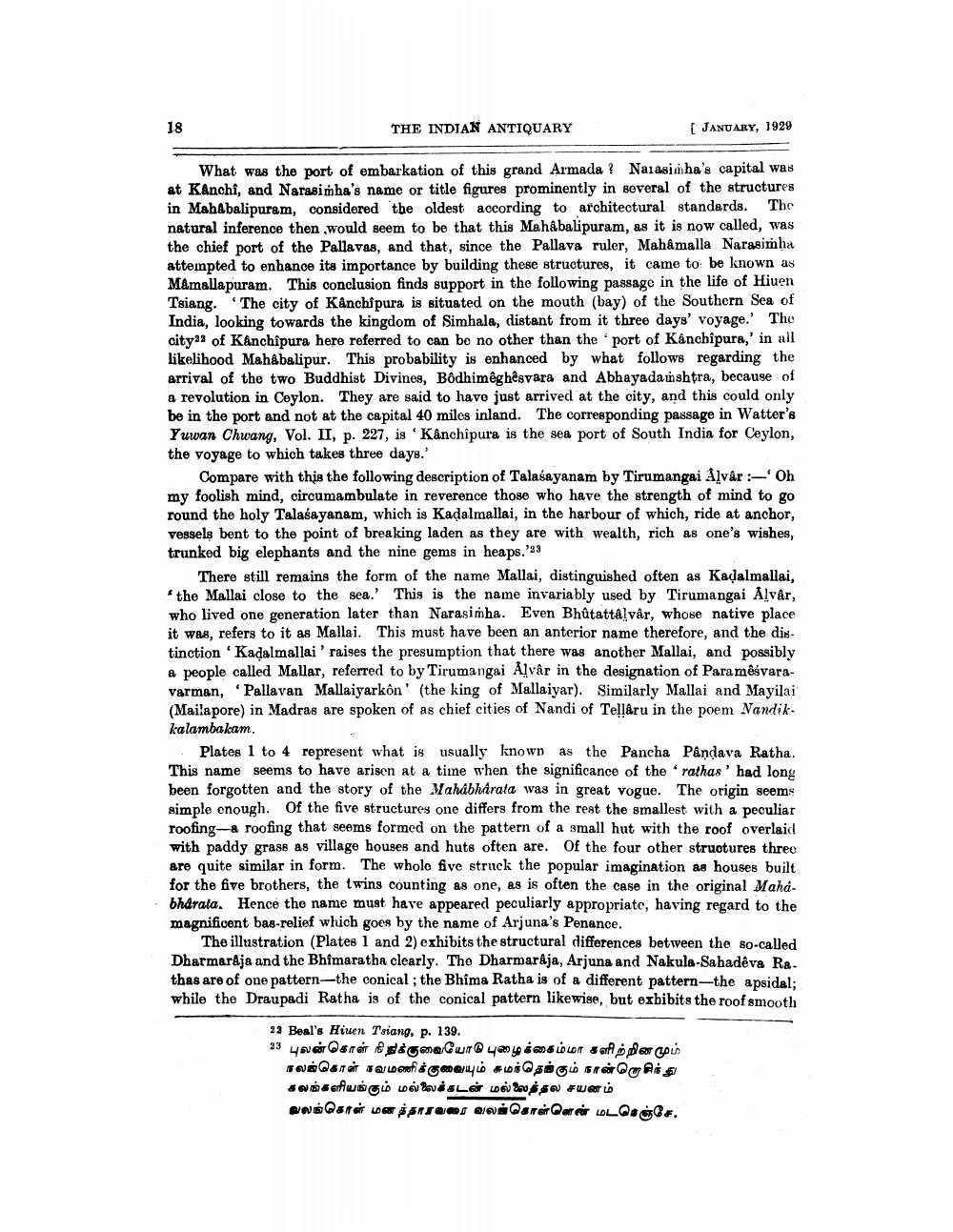________________
THE INDIAN ANTIQUARY
[ JANUARY, 1929
What was the port of embarkation of this grand Armada ? Narasimha's capital was at Kanchi, and Narasimha's name or title figures prominently in several of the structures in Mahabalipuram, considered the oldest according to architectural standards. The natural inference then, would seem to be that this Mahabalipuram, as it is now called, was the chief port of the Pallavas, and that, since the Pallava ruler, Mahämalla Narasimha attempted to enhance its importance by building these structures, it came to be known as Mamallapuram. This conclusion finds support in the following passage in the life of Hiuen Tsiang. The city of Kanchipura is situated on the mouth (bay) of the Southern Sea of India, looking towards the kingdom of Simhala, distant from it three days' voyage.' The city of Kanchipura here referred to can be no other than the port of Kanchipura,' in ail likelihood Mahabalipur. This probability is enhanced by what follows regarding the arrival of the two Buddhist Divines, Bodhimêghêsvara and Abhayada mshtra, because of a revolution in Ceylon. They are said to have just arrived at the city, and this could only be in the port and not at the capital 40 miles inland. The corresponding passage in Watter's Yuwan Chwang, Vol. II, p. 227, is 'Kanchipura is the sea port of South India for Ceylon, the voyage to which takes three days.
Compare with this the following description of Talaśayanam by Tirumangai Alvar :- Oh my foolish mind, circumambulate in reverence those who have the strength of mind to go round the holy Talasayanam, which is Kadalmallai, in the harbour of which, ride at anchor, vessels bent to the point of breaking laden as they are with wealth, rich as one's wishes, trunked big elephants and the nine gems in heaps.'33
There still remains the form of the name Mallai, distinguished often as Kadalmallai. *the Mallai close to the sea. This is the name invariably used by Tirumangai Alvår, who lived one generation later than Narasimha. Even Bhûtattálvår, whose native place it was, refers to it as Mallai. This must have been an anterior name therefore, and the distinction 'Kadalmallai' raises the presumption that there was another Mallai, and possibly a people called Mallar, referred to by Tirumangai Alvår in the designation of Paramèśvaravarman, Pallavan Mallaiyarkón' (the king of Mallaiyar). Similarly Mallai and Mayilai (Mailapore) in Madras are spoken of as chief cities of Nandi of Telleru in the poem Nandik. kalambakam.
Plates 1 to 4 represent what is usually known as the Pancha Pandava Ratha. This name seems to have arisen at a time when the significance of the rathas' had long been forgotten and the story of the Mahabharata was in great vogue. The origin seems simple enough. Of the five structures one differs from the rest the smallest with a peculiar roofing-a roofing that seems formed on the pattern of a small hut with the roof overlaid with paddy grase as village houses and huts often are. Of the four other structures threo are quite similar in form. The whole five struck the popular imagination as houses built for the five brothers, the twins Counting as one, as is often the case in the original Mahabharata. Hence the name must have appeared peculiarly appropriate, having regard to the magnificent bas-relief which goes by the name of Arjuna's Penance.
The illustration (Plates 1 and 2) exhibits the structural differences between the so-called Dharmaraja and the Bhimaratha clearly. The Dharmaraja, Arjuna and Nakula-Sahadeva Ra. thas are of one pattern-the conical ; the Bhima Ratha is of a different pattern-the apsidal; while the Draupadi Ratha is of the conical pattern likewise, but exhibits the roof smooth
22 Beal's Hiuen Tsiang, p. 139. 23 புலன் கொள் நிதிக்குவையோடு புழைக்கைம்மா களிற்றினமும் நலங்கொள் நவமணிக்குவையும் சுமந்தெங்கும் நான்சொசிந்து கலங்களியங்கும் மல்லைக்கடன் மல்லைத்தல சயனம் வலங்கொள் மனத்தாரவரை வலங்கொள்ளென் மடசெஞ்சே.




